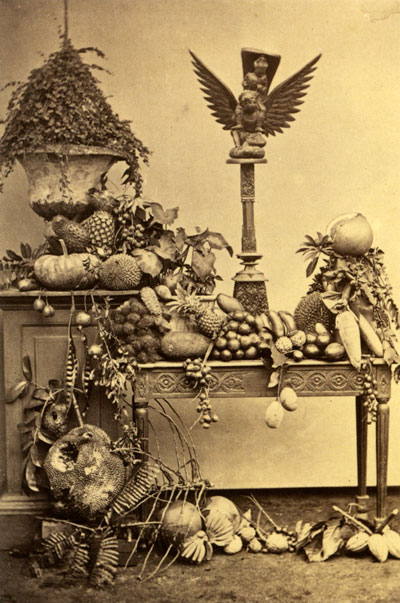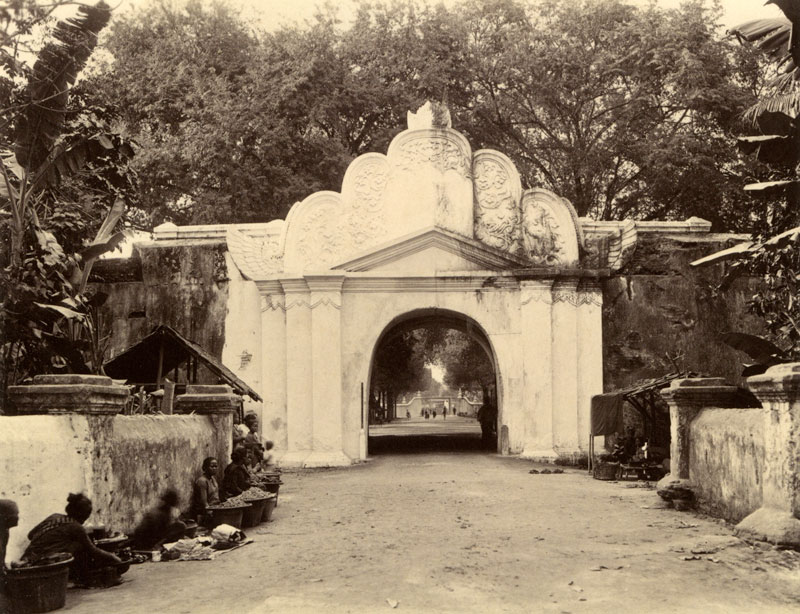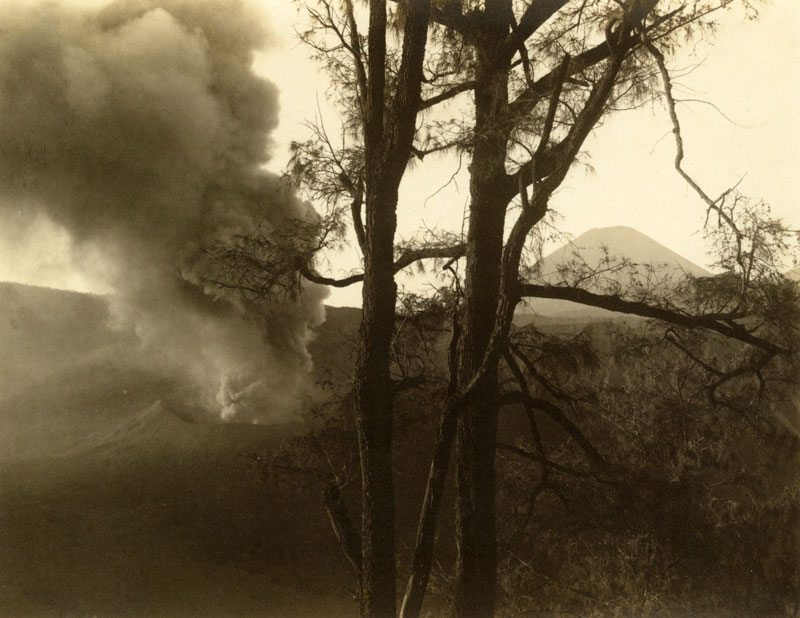In The Sun
Import, export and home-grown photography
Garden of the East: photography in Indonesia 1850s-1940s
Gael Newton
Originally published in the NGA's Artonview 77 Autumn 2014
 |
| Unknown photographer, Woman from Bogor c 1890, albumen silver photograph 20 x 25 cm, National Gallery of Australia Purchased 2013 |
From the early 1840s reports of the new illustrative medium of 'sun pictures' rapidly travelled along the trade routes of Asia and the Pacific. The news was soon followed by the arrival of imported camera kits and examples of mirror-like miniature daguerreotypes on metal plates and, from 1851, of the new 'wet-plate' process which produced unlimited numbers of richly detailed prints on glossy paper from a single glass negative.
Access to the new services, including the much desired personal 'likenesses! waited on the arrival of enterprising young men advertising themselves as a 'daguerreian artist! 'photographist' and then,'photographer! Their new vocation was well established worldwide by the early 1860s, but until the 1890s photographers in both Asia and Australia largely came from the colonial heartlands in Europe.
As early as December 1839, French artist Theodore Maurisset had depicted the world's first travelling photographer as a slim, dark-suited figure with his 'appareil pour le voyage' – a portable camera and tripod tucked under his arm. The image of the photographer at work outdoors with his dark tent (early photography had to be exposed and developed on the spot) became a staple of histories of the medium.
Relying on customers from many nations and races, needing to undertake endless negotiations with officials as well as the coolies, and having to lug their equipment on excursions, meant that photographers in foreign lands needed to be both competent and charming. In Asia the photographers adopted a spotless white suit, the uniform of their expatriate European customers.
While daguerreotypy and the related cased ambrotype process on glass plates of the 1850s-70s were well established in Australia, examples of the many thousands of plates made in Asia, including Indonesia, are almost non-existent and can be glimpsed only in reproductions. The first and most varied widely disseminated views of Indonesia in the 1860s-80s came from the Jakarta based studio of the British photographers Woodbury & Page (Artonview 76 Summer 2013, pp. 20-22).
Like many foreign photographers the founders of Woodbury & Page returned to Europe, but others, such as the Flemish-Dutch theatrical performer, artist and photographer Isidore van Kinsbergen, lived out their lives in Java. Kinsbergen produced a popular series of elaborate still life tableaux of native types and indigenous aristocrats in the 1860s and made the first extensive record of antiquities at Borobodur in 1873.
 |
|
 |
Isidore van Kinsbergen
Javanese fruit c 1865 albumen silver photograph 15.5 x 10.7 cm National Gallery of Australia, Purchased 2013 |
|
Cesar von Diiben
Princesses (Java) 1857 plate from Memories from the East Indies, CE Fritzes, Stockholm, 1886 lithograph after a photograph 15.7x24.2 cm National Gallery Research Library |
The family of Muslim Sultan of Yogyakarta, Hamengkubuwono VI, was one of the first to be photographed in 1857 by Swedish adventurer photographer Cesar Diiben. The Sultan sought to have a courtier trained in photography and accepted the gift of Diiben's camera in 1858, but had to wait until 1871 when his Javanese court official, Kassian Cephas, learned the process from the then official court photographer, Dutchman SW Camerik.
Cephas went on to a remarkable career as a professional photographer, respected and honoured for his record of Javanese antiquities and culture. His work has an elegant calligraphic design allied with the styles of traditional Javanese art.
Other than portraits, a substantial part of the output of the foreign owned and operated photographic studios established in mid to late nineteenth-century Asia were views of exotic places and people, sold as souvenirs and for export. The first of these from Indonesia reached Europe and America in the late 1850s, setting stereotyped impressions of the Indies and its ancient monuments, of tropical fruits and dusky maidens that last to the present day. Another major income stream that developed for the studios were urban and pastoral images for export that had more to do with real estate and agribusiness opportunities than natural beauty.
Increasingly, resident 'westerners' many born in Asia, as well as affluent Indonesian, Chinese and Malay customers, comprised a domestic market sufficient to keep more studios in business and support growing numbers of locally-born photographers.
By 1900 photographic illustration was the norm in publications, and the heavy family album and portable portrait on card was a staple of domestic life.
International companies led by Kodak in America had created a worldwide industry catering both to professionals and to the huge middle class of amateur snapshooters, tourists and keen camera club members. The camera now went everywhere and was charged with keeping memories alive. A small number of amateur and professional photographers were influenced by romantic turn-of-the-century salon style art photography.
 |
Kassian Cephas, The southern gate of the kraton of the Sultan of Yogyakarta c 1890
albumen silver photograph, 9.8x13.7 cm, National Gallery of Australia Purchased 2013 |
The top professional studios in Indonesia in particular followed trends in advertising overseas and supplied artistically styled illustrations for advertising and tourist brochures. The flourishing shipping cruise lines and tourist offices of the early twentieth century happily praised the artistry of their favoured studios. A by-product of early tourist promotions was the passion for pilgrimages to Bali by artists, writers and photographers in search of a tropical paradise, free of the political turmoil and industrialised modern life of their homelands.
No European photographer in the tropics could work without the services of local coolies and servants, many of whom became skilled technicians, but few assistants – whether Javanese, Balinese or Sumatran – ever became known professionals. With the advent of easy commercial processing and international suppliers, Chinese and Peranakan (Chinese-Malay) run studios emerged in the 1890s. These studios inclined more to providing portraits, but also marketed views, and often bought the negative stock of earlier European owned studios as they closed.
Japanese studios were also a significant group, with S Satake – originally a print and decorative art dealer from Yokohama– being one of the longest running, from the 1910s to 1930s. Satake travelled around in a special caravan, photographing views to which he brought the beauty of ukiyo-e prints.
As in Europe, many women worked in studios, as retouchers and processors, but only Indonesian-born Thilly Weissenborn – whose German-Dutch parents were planters – had a studio in her own right, in Garut in the resort upland area of west Java from 1917 to 1940. Like her younger Australian contemporary, Olive Cotton, Thilly's heart was in landscape work, to which she brought a hybrid Modernist and Pictorialist art photography style of luminosity.
Weissenborn trained in the Surabaya studio founded in 1887 by Armenian immigrant Ohannes Kurkdjian, then managed by British professional Geo P Lewis who had a distinctive art photography style. Weissenborn's work was extensively used for tourist and shipping line publications in the 1920s-30s. Like many Dutch nationals in Indonesia, Weissenborn suffered during World War II and later lost her archive. She returned to the Netherlands in 1956.
 |
| S Satake, Eruption, Java c1930, gelatin silver photograph, 16.2x21.8 cm, National Gallery of Australia, Purchased 2007 |
Two serious amateur art photographers presented in the exhibition are remarkable for their bodies of artistic documentary work. The German-Dutch doctor Gregor Krause, who worked for the Dutch colonial military and petroleum companies in Java, Bali and Borneo from the 1910s-30s, was one of the first modern documentary photographers. His studies of landscape and the apes of Borneo were inspired by his ecological concerns. His 1920s-30s books and articles on Bali inspired a later generation of European and American photographers to seek out Bali as a 'last paradise!
The second figure is German Tassilo Adam, who came to Sumatra to work as a planter in 1899, became a photographer to aid his developing passion for ethnography of the Batak people and spent five years photographing at the courts of the four principalities of central Java in 1923-28.
Photographers in the 1930s, such as Portugese Shanghai-based dentist and merchant Arthur de Carvalho, were almost obsessed with the Hindu culture and lifestyle of the Balinese. They used modern cameras and, for the first time, photographs could capture action and place the viewer in the scene.
 |
Gregor Krause, Female orangutan with baby proboscis monkey c 1923 plate from his portfolio, Borneo, G Kolff & Co, Jakarta, 1926
photogravure 22.4x 29.4 cm, National Gallery of Australia, Purchased 2007 |
Many of the later photographers in this vein owe a debt to the influence of Hollywood movies and the genre of 'ethnographic-pictorialism! which mixed the romanticism of the non-industrialised tropics with degrees of serious ethnographic reportage. The realities of the hard labour of children on plantations and in factories attracted no European-style documentary exposes, rather these children provided subjects for rustic peasant images.
A particular feature of Garden of the East is a selection of family albums from the 1910s-40s, many bound in distinctive Japanese or Batik patterned cloth boards, that record the colonial lifestyle (for the affluent) in the Indies. Hundreds of these once treasured narratives ended up in the Netherlands in the 1970s and 1980s in estate sales of former Dutch colonial and Indo (mixed race) family members who had returned or emigrated after the establishment of the Republic of Indonesia.
In presenting Garden of the East the National Gallery of Australia seeks to excite interest in the photographers of Indonesia, to salute both their skill and contribution to the visual heritage of Asia.
Gael Newton was the Senior Curator, Photography, and the curator of the 2014 exhibition
The book Garden of the East: photography in Indonesia 1850s-1940s was available at the NGA Shop for $39.95 and selected bookstores nationally for $49.95.
more of Gael Newton's Essays and Articles
|